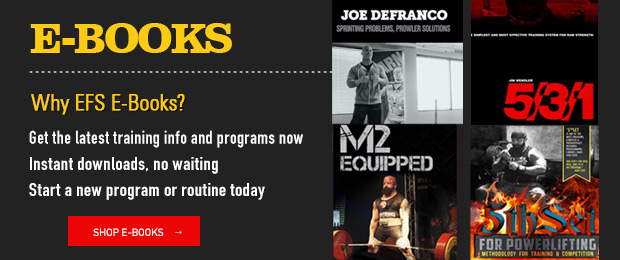
Strap in, cowboys, this is going to be a real ride!
I would like to start this third article about connecting the mind and muscle together with an explanation of just why this whole enterprise is worth the effort. It may seem that it is late in coming and would have perhaps been better placed in the very first article. Touché. It would have. But you will forgive me for having overlooked this.
You see, from my perspective, the reasons for doing such a thing (as connecting the two) are axiomatic. They are inherently obvious and go without saying. But that is only because of my own personal journey into resistance training.
RECENT: The Mind-Muscle Link: Learn Muscle Attachments
I was the scion of a great many benefactors who put me on the righteous path right from the beginning! They gave me a wonderful start. I was fortunate to have them set me straight at the very onset of my journey. This was what I thought was normal!
I too easily forget that most do not get such treatment and guidance from step one. Many ideas, therefore, I all too readily take for granted. They were granted me, and I forget how atypical and fortuitous that my early experience was. I want to pass them on now to you. Better late than never.
So let me digress and give some clarity to this operation. To begin, let me say that this level of engagement is not a qualifier for success in strength sports. No, far from it. However, that said, it is an absolute prerequisite for attaining one’s full potential. Even if you are a record-setter, if you haven’t walked the Holy Ground that I’m speaking about here, you have certainly left some of your potential unsung. The difference is in doing one’s best and being the best.
To revisit this idea, imagine the great basketball heroes of our present time: Michael Jordan and LeBron James. They play each game only to be the best that night, only to win. But if they were attempting to be their best, that would require them to strive to score more points and get more rebounds and have more steals than ever in their career each and every game. Every game is an opportunity to beat their last personal record and to constantly improve on every outing.
The point is that although they can reasonably be called the best basketball players, we cannot be certain if they are the best they can be. They are possibly able to perform so much higher than their opponents that they have not the need to develop the fullness of their potential to succeed and be the best in their sport.
Ask yourself when you watch them play if you think they are at the limit of what they are able to do. I do not know, but it is my impression that they are not. But if they can win without using the total of all potential within them, how can we know? This is the difference between being the best and doing your best.
The converse may be said as well. It is possible to do one’s best and still be far from being the best. This is easier to see. Only one is the best, but many of us can still be our best. Interestingly about strength sports is that we find they constantly push us not just to win the competition and be the best at the event but rather to go for personal records each time out. Every event. Every year. Every month. Every workout. This is different than winning the NBA Finals and not setting the all-time points record. Being our best is different than besting others.
The most important concept here is this: you must keep your focus upon yourself. Make no mistake — your potential has absolutely nothing to do with anyone else and their potential. Do not get confused. IT REALLY ISN’T A COMPETITION. The only real competition is with yourself. I talk incessantly about this, but it is still true each and every time I say it. So here it is one more time: you are only competing with yourself.
COMPETITION REPORT: Brute Strength Gym's Spartacus Strongman
Once you embrace this truth, you can more easily understand why the mind-muscle connection is imperative. Simply stated, you will NEVER be your best without mastering it, period. This is non-negotiable. It is not my rule; I just know how it works. All the words and talking in the world won’t get you out of this. Embrace this or know with certainty that you could have been more.
Your other option is to fool yourself with excuses. If you can live with that, I won’t stop you, but that is just one of the things that make you and I different. The bottom line here is that if you want to be the best you can be and exploit all the potential you have, you will learn to build the mind-muscle connection. You will go farther with it than without it.
There are of course more good reasons to learn this, but that will suffice for the driven among you. Just knowing that one could have left something on the table will motivate the true competitors out there. True competitors will demand this from themselves. This is because a true competitor is working with himself and not against himself, but above all... within himself.
If you are unconvinced of the importance of all this, I can only hope you wait this series out and read some other article of mine on another topic. I hope something else I say will be useful to you. Who knows... you might just come back to this one day and find an application for it.

As for continuing our road to making a connection to our muscles, let’s take up at the point just before we begin a repetition. Exactly when we decide to flex. Without making this more complicated than it already is, I refer to this process of our intention as “setting the mind.” Let’s call it willpower for lack of a better term.
To completely as possible engage a muscle in contraction, it is necessary to do some work in the mind before we even start. If we only concentrate on the actual movement of the bony levers and flexing of muscles, we have missed an important opportunity.
Remember this forever: THE BODY WILL GO ON AUTOPILOT IF YOU DON’T CONTROL THE MIND’S ATTENTION. Read that over several times so I don’t have to write it out a dozen lines. Do it. Read it again. And again.
What this means is that it is the body’s natural and normal state is to do things by rote and default. It is the modus operandi. You go about your day largely unaware of your body. To prove this, think about your socks right now. Can you feel them on your feet? Don’t move about trying to feel them, just sit still and see if you can. I’m betting you felt them when you put them on, and although they are still on, you have let the sensation fade into the deep background.
The body does this for a good reason. It allows your conscious attention to attend to more important things than feeling the socks on your feet. Really try to sense them. Now ask yourself if at the moment you were trying very hard to feel your socks on your feet if you kept reading. I’m betting you had to stop reading while you made the effort to feel your feet. Not only am I betting on it, I know beyond doubt that it happened that way. I know this because I was taught how the brain moves awareness.
WATCH: Joe Sullivan Demonstrates Crocodile Breathing
Especially what we call focus. Conscious focus can flit and move amazingly fast back and forth from thing to thing, but it cannot hold in focus two things at the exact same time. The research is clear on this.
No matter what you feel or think you feel about this issue, it is true. Ask any proficient magician you know. Many tricks are accomplished by this awareness of blindness. If you focus strongly on one thing, your awareness of another by necessity goes black.
Again, not my rule. This is important to know for two reasons:
- To understand the innate mechanism of default and how little of the body we are aware of normally, and;
- To appreciate the transience of attention and learn to guide it. We can improve at moving swiftly back and forth between groups of things with practice.
In other words, our attention is trainable.
What you are doing by attempting to build a mind-muscle link is to heighten this awareness and thereby the control of the muscle. The ability to shift from the ordinary state of consciousness in which very little attention is directed toward the body to that of an attention highly actualized on and dare I say in the body is a skill you can master. Once this becomes a more familiar place to abide, so to speak, you can delve ever deeper into it and I am convinced you will be astounded at what you can find there.
You are somewhat familiar with this as a matter of life experience. When caught up in an extremely pleasurable physical endeavor such as sex (if it’s done right) or enjoying a great meal at a leisurely pace or viewing art (a favorite method of teaching and practicing this, aside from the other favorite which you can’t practice with just anyone) or even a relaxing soak in a warm tub, remember a time when your body was in a very comfortable or pleasurable way and how you tried naturally to enjoy it to the fullest. What was your mind like then?

I’m betting you tried to slow time and savor all you could. You paid attention to both the overall sensation as well as the areas of your body most affected. And I will speak for myself and say that a very strong motivation strikes me to attempt to put the moment keenly into my memory. I deliberately ask myself to never forget this.
Unfortunate as it is, there is the reciprocal in effect as well: pain and discomfort. When in great pain, the attention is drawn to the body like a moth to a flame. This I take to be an evolutionary plus as it forces us to deal with the cause and attempt to extricate our body from the source. I have also worked in reverse — practice dealing with pain to attempt to ignore it. But if you’ve had anything more painful than a blister or hangnail, you know how difficult it is to remove your attention from your body. That is for another article!
The case I’ve made is that you already know what I’m talking about. Now you can choose to develop it. I say this phrase constantly as well: It begins from the inside out. You start with your brain/mind, and the body follows. There is a gap. A delay. You have to begin by setting your mind.
RELATED: Pushed by Pain, Pulled by Purpose
How the mind works is a mystery to me just as much as the next man. But without knowing exactly how the mind works... I know better than most how to work the mind. I know how to engage whatever it is to affect change on my environment, both internal and external. What it is, I can’t precisely say. But how to get it to do stuff, well, that I actually do have a few pointers you might find handy.
When I tell you to “set your mind,” I want you to think about what it is you are going to focus upon. What you wish to listen to and do. In the current scenario, we want to engage and connect with the muscle. Imagine the muscle from origin to attachment in your mind’s eye. If it is possible, try to look at it on your body or in a mirror. Then, by a small act of will, try to feel the muscle in your body. This was the gist of the last article. At this point, you have to set your mind on changing from ordinary awareness of the body (which is low) to a heightened sense of feeling especially in the muscle you are about to contract.
If you think you have ADD or ADHD, you might want to run from this exercise, but don’t! Doing this can only increase your attention span over time. And since it is visceral and not so abstract, you could very well decide in the future that you don’t at all have an attention disorder.
I know this because it happened to me. In grade school, I was unable to sit still or stop talking to my classmates. I was routinely punished for my misbehavior. But fortunately for me, I could get reasonable grades and was only ostracized and embarrassed in front of my classmates. There was no ADD back then… just crazy kids. I avoided medication and diagnosis.
Well, what do I have to say for myself now? I will not boast, but I can say unequivocally that I have absolutely no problem whatsoever concentrating these days. In fact, some would say I excel at it. The point is that I suspect many of you were told that you had some problem, and the worst part of it is that you still believe them. Well, don’t. It’s your show now and I’m betting on you. You can improve dramatically in terms of focus and attention.
At this point, it is up to you to decide if you believe them or me. But what are they promising you? Why not get on the bus with me? You can always get off at the next stop if I’m wrong. It’s your call... but the bus is leaving the station. If I can do it, you can too.

You must start believing that you can concentrate as well as the next guy. If you can’t at the moment, say that. For the moment. Don’t say, “I can’t focus.” Instead, say, “I’m not as good at focusing as I want to be right now, but I’ll get there sooner rather than later. But today is tough.” Then keep working on it!
No matter how or when you get there, you have to set your mind on this and only this contraction and then you must not waver. Every time your attention wanders, you have to employ your discipline to bring it back to the muscle and the contraction. This can be several times during the movement. It goes away, you bring it back. It goes away again, you bring it back again ad infinitum. This is the drill. This is the exercise. This is the work. And ultimately, this becomes the practice.
LISTEN: Table Talk Podcast Clip — JM Blakley and Dave Tate Discuss Meditation for Athletes
I will attest that if you lose focus even for a split second, the attention reverts to the default situation and the body is ignored. It is up to you to notice when this has happened and to guide it back. There is a wonderful Tibetan tradition of meditation that uses the notice-return path. You attempt to think of nothing (or more suitable for western minds a single thing like a candle flame) and only allow your consciousness to rest upon that. When you notice that something else has captured your attention (often the conversation going on in your own head with yourself) bring it back to the single point. The Chinese say, “to get rid of the 10,000 things, think intently on one thing.”
When you fill your mind up to the hilt with one thing, all the rest of the things disappear. This can be excellent stress relief, but the method of bringing the attention back to a place of your choosing is our application. It has been said that the human mind is like a monkey. It can’t sit still. Or even a monkey that has been stung by bees! Etcetera.
But taming the monkey-mind is actually easier than they would have you believe. Yeah, I said easier. The secret is unrelenting practice. If you are on the fence about this, ask yourself how many minutes you spent in the gym exercising this week. Now ask how many minutes you spent training your attention. I rest my case. No wonder your inner monkey is getting the best of you! You’ve spent very little time taming it! It is not that hard... you just aren’t putting in any effort!
This brings us to the juncture of actually flexing the muscle and paying attention to it. I have called this the intention-attention loop in previous articles. Let me describe to you what I do and think of when I attempt such a thing, to connect my mind and muscle, just in case my preceding words and explanation relied on my own bias from my past.
I will select the biceps because I can see the muscle in plain view as I flex. Also, it is a fusiform type fiber set up with the fibers running straight from attachment to attachment. It’s about as simple as it gets.
I can “see” the muscle in almost cartoon or diagrammatic form in my head. I am so practiced that this comes up without effort. You may have to use modern technology and look at a few pictures and videos on the web to clarify this in your mind before the workout. After a short while, it will appear for you automatically as well.
I select a modest weight and choose the specific exercise. I begin by placing the muscle in a relaxed and stretched position. I stare directly at it. At this point, I set my mind on focusing upon the muscle as well as the level of effort I am willing to give. This happens before I move.

People watching me say that I usually, as a custom, inhale deeply and exhale slowly. Maybe I do. That is for another article as well. But in my mind, I remind myself that this is not an ordinary situation. I give the command that this is an almost desperate situation that requires my full attention.
I create a false emergency of focus. It’s not life or death, but my subconscious mind doesn’t know that. If I insist that it is consciously, the subconscious must play along. I resolve to keep on track and let nothing distract me. I resolve to be impervious to anything but my muscle. This is a deep commitment and promise I make to myself. I will not be dissuaded. I am resolute. I am committed.
I cannot overstate the importance of doing this prior to beginning to flex. The times that I slip and don’t do so, I have to immediately try my best to recover, but that rep is always a struggle. The finest reps occur when I take the time and pay the mental effort price in my head first. And it sets the tone for the entire rep. My best reps are unhurried and very deliberate.
LISTEN: Table Talk Podcast #19 with Leslie Eiler Thompson
I begin to almost gently send the signal to my muscle to contract. The slack is taken out of the muscle, and I feel it begin to increase the internal pressure that I spoke about in a previous article. This pressure builds, but I have not moved yet. The tendon and muscle belly are tightened up the literal slack from the resting length of the biceps.
Now, as I have insisted in my other articles, I begin to increase the motor signal to flex my muscles VERY FUC@#$G SLOWLY. The bony lever will now, finally, begin to move. SLOWLY.
As this happens, I direct my attention to the longitudinal pressure that builds up going down the length of my biceps. This is the actual resistance of the weight. As I move, this tension changes due to leverage advantage and disadvantage throughout the range of movement.
In a standing biceps curl, the first few degrees and the last several are much easier than at the sticking point near the halfway part of the motion (near 90 degrees). I become aware of this and work through and with it. I employ the intention-attention loop and monitor it constantly, asking my body to report in on how well the command was obeyed. If the report is lacking, I can re-send another signal with instructions that are clearer to the troops. This goes on all through the rep, over and over. Always striving for the best, deepest contraction I can muster.
I am able to quickly shift attention back and forth from internal pressure to longitudinal tension many times during the rep. There are hot spots that are not only more or less difficult but also offer more or less feedback all through the range. I make sure to identify them. I will expound on hot spot training in another installment. For now, it is all just a part of becoming aware of it for this place in our training.
Be sure you can tell the difference between the pressure you feel from the weight resisting you and the pressure you create by flexing the muscle. Know what internal pressure feels like in relation to longitudinal pressure. They happen simultaneously, and it is a skill to know one from the other. This is important because one is in your control and the other is set by the weight and leverage. Most people are only aware of the weight and unaware of the pressure they can control!
One place to spend extra time and attention is at the very fullest part of the muscle contraction — the so-called “peak.” At the point when the muscle can no longer shorten any further due to the ligaments and tendons and the actual bones being in the way, it is a physical limitation. There is still an opportunity to cause an increase in muscle tension. It is an isometric contraction of extremely high tension and very valuable even though no movement occurs.

Even though the general sense is that you are stuck and cannot possibly shorten the muscle any further, the muscle fibers have no way to know that, and if you continue to send a signal to contract, they will continue to try to do so. This will have the effect of you feeling an increase in longitudinal pressure as well as a simultaneous increase in internal pressure. It is like the best of both worlds. Even if (as in a standing biceps curl) the top or end of the movement provides little resistance from the weight due to leverage, if you keep trying to shorten the muscle, you feel an overwhelming tension.
There is lots of advice given about how long to hold the isometric, but it is inordinately difficult to do it for very long at all at maximum. Try a two-count for starters! I say “ hard... harder” to myself on each count, then release and continue the rep. Holding a sub-maximal isometric is counterproductive in my opinion, and I would rather put the effort into something that doesn’t just make me tired but makes me grow.
READ: Make Light Weight Heavy with Controlled Eccentrics and Concentrics
To illustrate this for yourself, try a 10 count. You will feel a high pressure at first, then a precipitous drop at about the count of five, until at 10 you are well below any contraction that can do you any good. Or maybe you can train up to it. But for my sweat, it’s not worth it.
Whatever your personal hold time ends up to be, it will be better than if you did not perform the isometric on each rep. I call it squeezing the rep. Some say peaking. And some call it what it is a Maximal Voluntary Isometric Contraction (MVIC) in the literature. Here is something you should know about MVICs: They are the absolute highest tension you can create in a muscle. And knowing that it is tension that stimulates a muscle to grow, you should take a special interest. There are lots of ways to incorporate isometrics into your workouts, but that is for another article. Here is a very good start.
Upon the release of the isometric at the peak of the contraction, the work is only half done. There is plenty of growth that can come from lengthening the muscle. The same emphasis on slowing down must be maintained. Because it is easier to lower weight than it is to raise it, this affords one an opportunity to concentrate even more on the feeling in the muscle. I can recall many movements that taught me more on the lowering phase (the eccentric) than on the raising (concentric). Be especially open to learning when you lower the weight or lengthen the muscle back to its normal resting place.
When you do come back to the start, you must completely relax the muscle. This allows the slack to form again. It takes 15 percent more energy to do this full slack-to-contraction back-to-slack than it does to “stay tight” at the bottom. This is why you hear “stay tight”’ so frequently at lifting meets. It is way, way harder if you loosen up! You already know this intuitively. But in this style of training, going slack helps us learn.
We are not interested in maximum weight, but rather a maximum contraction. So go slack and then slowly remove the slack before you move the weight. This is a very good way to understand contraction versus movement. I don’t know a faster way to teach it.
We are far from the end of this path. But this is a good place to rest awhile. You would never believe me if I told you how far this goes. Never. What would you do if you had something extremely important to tell somebody but you knew for a fact they would not believe you? Well, what would you do?
Maybe you would do what I have decided to do. I am giving out the concept in small, easier to digest little, tiny tidbits. The truth is that we haven’t even taken a proper bite yet. But, even so, what I have given you will last for years of practice and development. I can and do revisit everything I have written about so far almost weekly. It’s a long way to perfection. I’ve been at this for over three decades and I am uncovering more all the time. That is not hyperbole. It’s true.
This rabbit hole is deep, my friends. But at any level it is rewarding. Every ounce of effort comes back sevenfold to you, to borrow a scripture verse. Nothing concerning the development of mental acuity goes unpaid. I can promise little in this capricious world, but I can promise that this is worth it. If I am wrong, you can always ask for a full refund! The check is in the mail.
MORE: 4 Max Effort Method Principles to Master
I will move away from this concept for several articles. When we return to it, I will outline the role that antagonistic co-contraction can play in increasing tension and fiber recruitment. As for now, I have described plenty of concepts and exercises to work on.
The reward is legion and the effort required is commensurate. But nothing this good comes easy or free. If you are willing to pay, you will be in the same gym as always, but you will be in a whole new place!
Header image courtesy of Andrea Danti © 123rf.com










